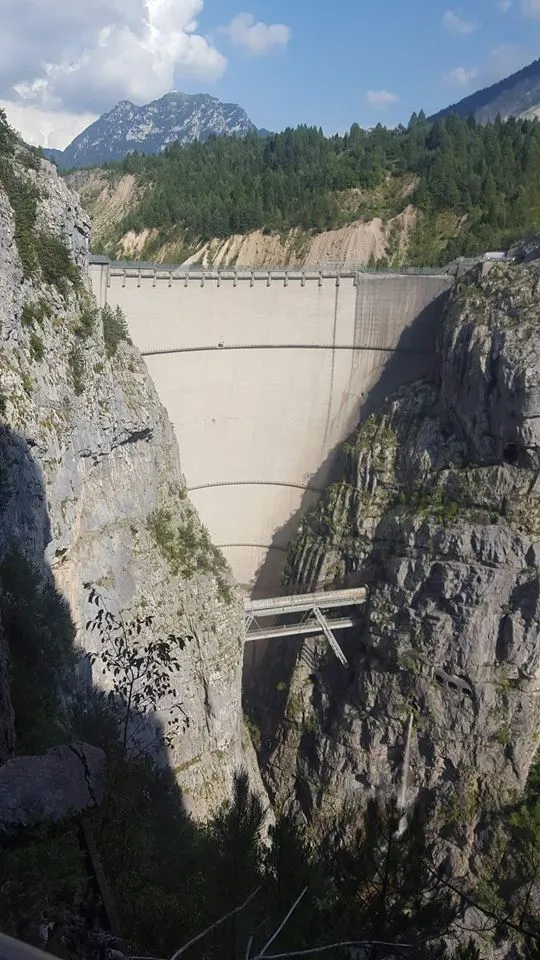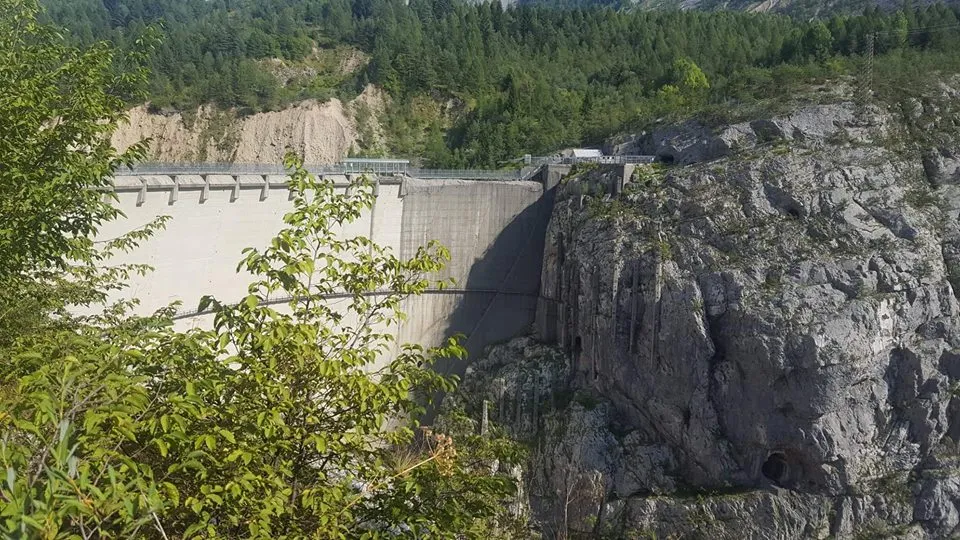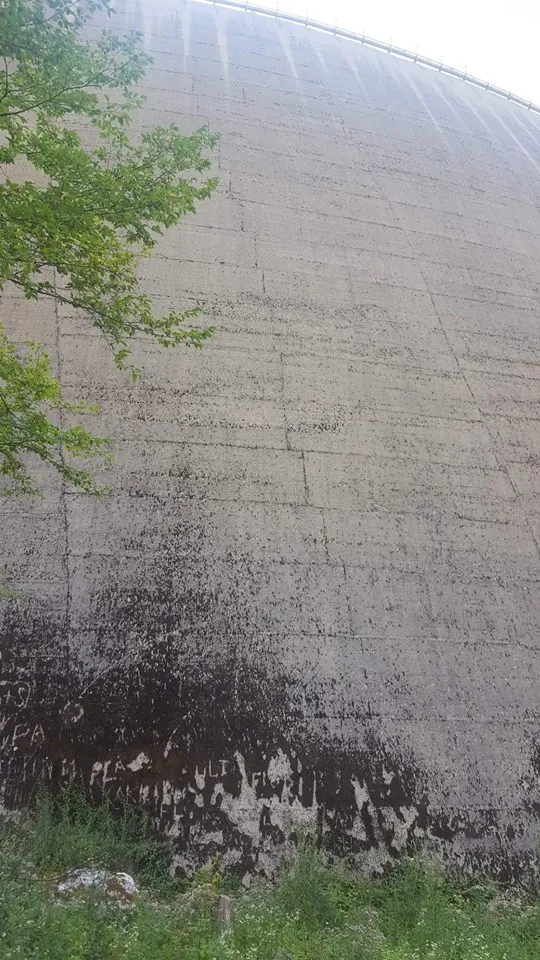In una bella giornata di Agosto, io ed il mio moroso, abbiamo deciso di andare a visitare i resti della diga del Vajont.
In tanti ricordano l'accaduto come un tragico evento, che distrusse in pochi istanti l'intera città di Longarone.
Il luogo è molto suggestivo, ed il tempo sembra essersi fermato al momento del disastro.
Lungo la strada, sono presenti tanti bigliettini colorati, con i nomi di tutti i bambini che quella notte persero la vita.
Ora vorrei soffermarmi un po' sui cenni storici, e fare delle opportune riflessioni.
Il disastro avvenne la sera del 9 ottobre 1963, gli abitanti di Longarone ( una cittadina friulana, in provincia di Belluno), si radunarono per vedere una partita in TV; quando all'improvviso una frana del monte Toc precipitò nel bacino della diga, creando un'inondazione e distruggendo il paese.
Persero la vita ben 2000 vittime, tra cui 487 bambini e ragazzi sotto i 15 anni.
Che funzione aveva questa diga?
Era sede di una delle più importanti centrali idro-elettriche di Italia.
Come mai avvenne questo disastro?
Tutto ciò venne causato dal sollevamento delle rocce.
A partire da 30 milioni di anni fa, i calcari e le alternanze di calcari e di argille vennero piegati, fratturati e successivamente sollevati in seguito all'azione di forze interne della terra, che diedero origine alla catena delle Alpi; in seguito a tali sconvolgimenti, le rocce che andarono a costituire le pendici del monte Toc divennero molte inclinate.
Anche tale situazione , determina solitamente una certa instabilità del rilievo. ed infatti la superficie di distacco della frana venne a coincidere proprio con il piano inclinato, che sale dalla valle verso la cima del monte Toc.
Come mai questo disastro fu così devastante?
La frana che si staccò dalle pendici settentrionali del monte Toc, aveva dimensioni gigantesche: con un fronte superiore a 2 km, una larghezza di almeno 500 m, ed un'altezza di circa 250, essa trasportò a valle 270 milioni di metri cubi di rocce e detriti.
é come se, su una superficie pari a 2000 campi da calcio, si riversasse uno strato di materiale alto circa 2,5 volte il campanile di San Marco.
Tale massa, se venisse asportata da 100 camion, calerebbe di 1 mm al giorno: a tali ritmi, per rimuoverla tutta, sarebbero necessari ben 7 secoli!
Questa tragedia si poteva evitare?
é una domanda che ci si pone da 58 anni.
Quel tardo pomeriggio del 9 ottobre 1963, da una chiamata della direzione del servizio idro-elettrico, della sede Enel di Venezia, giunse l'ordine al capo centrale di Soverzene, di recarsi in diga, in previsione di un'imminente frana.
Era forse possibile, allora, provvedere ad uno sgombero tempestivo degli abitanti del loco.
Il Vajont oggi è meta di frequenti visite guidate, negli ultimi anni l'attenzione su quel tragico episodio è tornata viva.




le foto sono di mia proprietà
On a beautiful August day, me and my boyfriend, we decided to go and visit the remains of the Vajont dam.
Many remember the event as a tragic event, which destroyed in a few moments the entire city of Longarone.
The place is very impressive, and time seems to have stopped at the time of the disaster.
Along the way, there are many colorful cards, with the names of all the children that lost their lives that night.
Now I would like to focus a bit on the historical background, and make some appropriate reflections.
The disaster occurred on the evening of October 9, 1963, the inhabitants of Longarone (a town in Friuli, in the province of Belluno), gathered to watch a game on TV; when suddenly a landslide of Mount Toc crashed into the dam basin, creating a flood and destroying the country.
As many as 2,000 victims died, including 487 children and young people under the age of 15.
What function did this dam have?
It was home to one of Italy's most important hydro-electric plants.
Why did this disaster happen?
All this was caused by the lifting of the rocks.
Starting from 30 million years ago,limestone and the alternations of limestone andclay were bent, fractured and subsequently raised following the action of internal forces of the earth, which gave rise to the Alps chain; as a result of these upheavals, the rocks that formed the slopes of Mount Toc became very sloping.
Even this situation usually determines a certain instability of the relief. and in fact the surface of detachment of the landslide coincided precisely with the inclined plane, which rises from the valley towards the top of Mount Toc.
Why was this disaster so devastating?
The landslide that broke away from the northern slopes of Mount Toc, was gigantic: with a front over 2 km, a width of at least 500 m, and a height of about 250, it carried 270 million cubic meters of rocks downstream and debris.
It is as if, on a surface equal to 2000 football fields, a layer of material about 2.5 times high is added to the bell tower of San Marco.
This mass, if removed from 100 trucks, would drop by 1 mm per day: at such rates, to remove it all, it would take 7 centuries!
Was this tragedy possible?
It is a question that has arisen for 58 years.
That late afternoon of October 9, 1963, from a call of the hydro-electric service, of the Enel headquarters in Venice, the order arrived at the central head of Soverzene, to go to the dam, in anticipation of an imminent landslide.
It was perhaps possible, then, to provide for a timely eviction of the inhabitants of the area.
Today the Vajont is a destination for frequent guided tours, in recent years the attention on that tragic episode is back alive.
Fonti: Wikipedia;
Cartelloni presenti sul loco;
Ricerche internet
